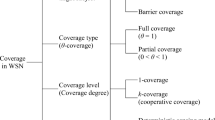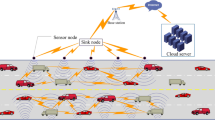Abstract
Coverage is a significant performance indicator of wireless sensor networks. Data redundancy in k-coverage raises a set of issues including network congestion, coverage reduction, energy inefficiency, among others. To address these issues, this paper proposes a novel algorithm called complex alliance strategy with multi-objective optimization of coverage (CASMOC) which could improve node coverage effectively. This paper also gives the proportional relationship of the energy conversion function between the working node and its neighbors, and applies this relationship in scheduling low energy mobile nodes, thus achieving energy balance of the whole network, and optimizing network resources. The extensive simulation results demonstrate that CASMOC could not only improve the quality of network coverage, but also mitigate rapid node energy consumption effectively, thereby extending the life cycle of the network significantly.

























Similar content being viewed by others
References
Wei, W., Yang, X., Shen, P., & Zhou, B. (2012). Holes detection in anisotropic sensornets: Topological methods. International Journal of Distributed Sensor Networks, 2012, 1–9.
Xing, X., Wang, G., & Li, J. (2014). Collaborative target tracking in wireless sensor networks. Ad Hoc & Sensor Wireless Networks, 23(8), 117–135.
Sun, Z., Weiguo, W., Wang, H., Chen, H., & Wei, W. (2014). An optimization strategy coverage control algorithm for WSN. International Journal of Distributed Sensor Networks, 2014, 1–17.
Liao, Z., Wang, J., Zhang, S., & Zhang, X. (2013). A deterministic sensor placement scheme for full coverage and connectivity without boundary effect in wireless sensor networks. Ad Hoc & Sensor Wireless Networks, 19(3–4), 327–351.
Dong, M., Ota, K., Laurence, T. Y., Chang, S., Zhu, H., & Zhou, Z. (2014). Mobile agent-based energy-aware and user-centric data collection in wireless sensor networks. Computer Networks, 74(3), 58–70.
Tseng, Y., Chen, P., & Chen, W. (2012). k-Angle object coverage problem in a wireless sensor network. IEEE Sensors Journal, 12(12), 3408–3416.
Ghaderi, R., Esnaashari, M., & Meybodi, M. (2014). A cellular learning automata-based algorithm for solving the coverage and connectivity problem in wireless sensor networks. Ad hoc & Sensor Wireless Networks, Ad hoc & Sensor Wireless Networks, 22(4), 171–203.
Yanling, H., Dong, M., Ota, K., Liu, A., & Guo, M. (2014). Mobile target detection in wireless sensor networks with adjustable sensing frequency. IEEE Systems, 8(3), 1–12.
Yang, C., & Chin, K. (2014). Novel algorithm for complete targets coverage in energy harvesting wireless sensor networks. IEEE Communications Letters, 18(1), 118–121.
Wei, W., & Qi, Y. (2011). Information potential fields navigation in wireless ad-hoc sensor network. Sensor, 2011, 4794–4807.
Long, J., Dong, M., Ota, K., Liu, A., & Hai, S. (2015). Reliability guaranteed efficient data gathering in wireless sensor networks. IEEE Access, 3(2), 430–444.
Wang, Y., & Tseng, Y. (2008). Distributed deployment schemes for mobile wireless sensor networks to ensure multi-level coverage. IEEE Trans. Parallel and Distributed Systems, 19(9), 1280–1294.
Akhtar, F., & Rehmani, M. H. (2015). Energy replenishment using renewable and traditional energy resources for sustainable wireless sensor networks: A review. Elsevier Renewable and Sustainable Energy Reviews, 45(5), 769–784.
Yen, L., Changwu, Yu., & Cheng, Y. (2006). Expected k-coverage in wireless sensor networks. Ad Hoc Networks, 5(4), 636–650.
Kong, L., Zhao, M., Liu, X., Jialiang, L., Liu, Y., Minyou, W., & Shu, W. (2014). Surface coverage in sensor network. IEEE Transactions on Parallel and Distributed Systems, 25(1), 234–243.
Sendra, S., Fernandez, P., Turro, C., & Lloret, J. (2010). IEEE 802.11a/b/g/n indoor coverage and performance comparison. The Sixth International Conference on Wireless and Mobile Communications (ICWMC 2010), Valencia (Spain), September 20–24, 2010.
Garcia, M., Tomás, J., Boronat, F., & Lloret, J. (2009). The development of two systems for indoor wireless sensors self-location. Ad Hoc & Sensor Wireless Networks, 8(3), 235–258.
Sendra, S., Lloret, J., Turro, C., & Agriar, J. M. (2014). IEEE 802.11a/b/g/n short scale indoor wireless sensor placement. International Journal of Ad Hoc and Ubiquitous Computing, 15(2), 68–82.
Mohamed, L., Herve, G., & Mohammed, F. (2010). Cluster-based energy-efficient k-coverage for wireless sensor networks. Network Protocols and Algorithms, 2(2), 89–106.
Suárez, A., Santana, J. A., Maciaslopez, E. M., Mena, V. E., Canino, J. M., & Marrero, D. (2014). RSSI prediction in WiFi considering realistic heterogeneous restrictions. Network Protocols and Algorithms, 4(6), 19–40.
Matthieu, L., Faicel, H., & Hichem, S. (2011). Multi-objective optimization in wireless sensors networks, 2011 Internation Conference on Microelectronics (ICM 2011), Hammamet, Tunisia, pp. 1–4, 19–22 Dec. 2011.
Meng, F., Wang, H., & He, H. (2011). Connected coverage protocol using cooperative sensing model for wireless sensor network. Acta Elecronica Sinca, 9(4), 772–779.
Mini, S., Udqata, S. K., & Sabat, S. L. (2014). Sensor deployment and scheduling for target coverage problem in wireless sensor networks. IEEE Sensros Journal, 14(3), 636–644.
Li, Y., Chinh, V., Ai, C., Chen, G., & Zhao, Y. (2011). Transforming complete coverage algorithms to partial coverage algorithm for wireless sensor networks. IEEE Transactions on Parallel and Distributed Systems, 22(4), 695–703.
Iqbal, M., Naeem, M., Anpalagan, A., Ahmed, A., & Azam, M. (2015). Wireless sensor network optimization: multi-objective paradigm. Sensors, 7, 17572–17620.
Razafindralambo, T., & Simplotryl, D. (2011). Connectivity preservation and coverage schemes for wireless sensor networks. IEEE Transactions on Automatic Control, 56(10), 2418–2428.
Ammari, H. M., & Das, S. K. (2012). Centralized and clustered k-coverage protocols for wireless sensor networks. IEEE Transactions on Computers, 61(1), 118–133.
Junzhao, D., Wang, K., Liu, H., & Guo, D. (2013). Maximizing the lifetime of k-discrete barrier coverage using mobile sensors. IEEE Sensors Journal, 13(12), 4690–4701.
Zhu, C., Zheng, C., Shu, L., & Han, G. (2012). A survey on coverage and connectivity issues in wireless sensor networks. Journal of Network and Computer Applications, 35(2), 619–632.
Xing, X., Wang, G., & Li, J. (2014). Polytype target coverage scheme for heterogeneous wireless sensor networks using linear programming. Wireless Communications and Mobile Computing., 14(8), 1397–1408.
Sun, Z., Weiguo, W., Wang, H., Chen, H., & Xing, X. (2014). A novel coverage algorithm based on event-probability-driven mechanism in wireless sensor network. EURSIP Journal on Wireless Communications and Networking, 2014(1), 1–17.
Wang, H., Meng, F., & Li, Z. (2010). Energy efficient coverage conserving protocol for wireless sensor networks. Journal of Software, 21(12), 3124–3137.
Cheng, T. M., & Savkin, A. V. (2009). A distributed self -deployment algorithm for the coverage of mobile wireless sensor networks. IEEE Communications Letters., 13(11), 877–879.
Abrar, H., Chakrabarti, S., & Biswas, P. K. (2012). Impact of sensing model on wireless sensor network coverage. IET Wireless Sensor Systems, 2(3), 272–281.
Yoon, Y., & Kim, Y. (2013). An efficient genetic algorithm for maximum coverage deployment in wireless sensor network. IEEE Transactions on Cybernetics., 45(5), 1473–1483.
Sundhar Ram, S., Manjunath, D., & Lyer, S. K. (2007). On the path coverage properties of random sensor networks. IEEE Transactions on Mobile Computing, 6(5), 1–13.
Cardei, M., & Jie, W. (2005). Energy-efficient coverage problems in wireless ad-hoc sensor networks. Computer Communications, 29(4), 413–420.
Zhao, Q., & Mohan, G. (2008). Lifetime maximization for connected target coverage in wireless sensor networks. IEEE/ACM Transactions on Networking, 16(6), 1378–1391.
Jiang, H., Jin, S., & Wang, C. (2011). Prediction or not? An energy-efficient framework for clustering-based data collection in wireless sensor network. IEEE Transactions on Parallel and Distributed Systems, 22(6), 1064–1071.
Zhu, J., & Xiaodong, H. (2008). Improved algorithm for minimum data aggregation time problem in wireless sensor networks. Journal of System Science & Complexity, 21(4), 626–636.
Xiaohua, X., Li, X., & Mao, X. (2011). A delay-efficient algorithm for data aggregation in multihop wireless sensor networks. IEEE Transaction on Parallel and Distributed Systems, 22(1), 163–175.
Lei, L., Lin, C., Cai, J., & Shen, X. (2009). Rerformance analysis of wireless opportunistic schedulers using stochastic petri nets. IEEE Transactions on Wireless Communications, 8(4), 2076–2087.
Yanwei, W., Li, X., & Liu, Y. (2010). Energy-efficient wake-up scheduling for data collection and aggregation. IEEE Transactions on Parallel and Distributed Systems, 21(2), 275–287.
Jie, W., Fei, D., & Ming, G. (2002). On calculating power-aware connected dominating sets for efficient routing in ad hoc wireless network. Journal of Communications and Networks, 4(1), 1–12.
Oliveira, T., Raju, M., & Agrawal, D. P. (2012). Accurate distance estimation using fuzzy based combined RSSI/LQI values in an indoor scenario: Experimental verification. Network Protocols and Algorithms, 4(4), 174–199.
Elbes, M., Jordan, A., Fuqaha, A. A., & Anan, M. (2013). A precise indoor localization approach based on particle filter and dynamic exclusion techniques. Network Protocols and Algorithms, 5(2), 50–71.
Lloret, J., Tomas, J., Garcia, M., & Canovas, A. (2009). Hybrid stochastic approach for self-location of wireless sensors in indoor environments. Sensors, 9(5), 3695–3712.
Sendra, S., Lloret, J., García, M., & Toledo, J. F. (2011). Power saving and energy optimization techniques for wireless sensor networks. Journal of Communications, 6(6), 439–459.
Wei, W., Qin, X., Wang, L., Hei, X., Shen, P., Shi, W., & Shan, L. (2014). GI/Geom/1 queue based on communication model for mesh networks. International Journal of Communication Systems, 27(11), 3013–3029.
Jameii, S. M., Faez, K., & Dehghan, M. (2015). Multiobjective optimization for topology and coverage control in wireless sensor networks. International Journal of Distributed Sensor Networks, 1, 1–11.
Wei, W., Yang, X., Zhou, B., Feng, J., & Shen, P. (2012). Combined energy minimization for image reconstruction from few views. Mathematical Problems in Engineering., 2012, 1–15.
Acknowledgments
Projects (61170245, U1304603) supported by the National Natural Science Foundation of China; Projects (2014B520099, 2014A510009) supported by Henan Province Education Department Natural Science Foundation; Projects (142102210471, 142102210063, 142102210568) supported by Natural Science and Technology Research of Foundation Project of Henan Province Department of Science; Project (1401037A) supported by Natural Science and Technology Research of Foundation Project of Luoyang Department; Project (2014M562153) supported by Postdoctoral Science Foundation of China; Project (2012GGJS-191) supported by the funding scheme for youth teacher of Henan Province; Project (1201430560) supported by Guangzhou Education Bureau Science Foundation. This paper was also supported by China Postdoctoral Science Foundation (Nos. 2013M542370, 2014M562153) and the Specialized Research Fund for the Doctoral Program of Higher Education of China (Grant No. 20136118120010).
Author information
Authors and Affiliations
Corresponding author
Rights and permissions
About this article
Cite this article
Sun, Z., Zhang, Y., Nie, Y. et al. CASMOC: a novel complex alliance strategy with multi-objective optimization of coverage in wireless sensor networks. Wireless Netw 23, 1201–1222 (2017). https://doi.org/10.1007/s11276-016-1213-3
Published:
Issue Date:
DOI: https://doi.org/10.1007/s11276-016-1213-3




